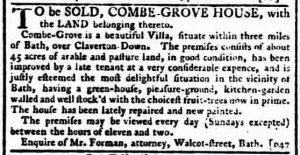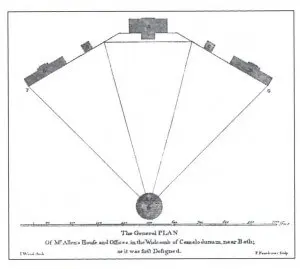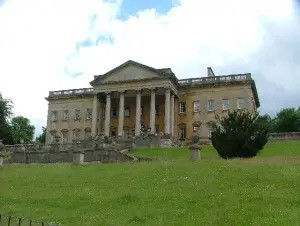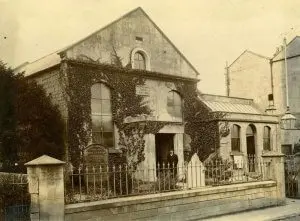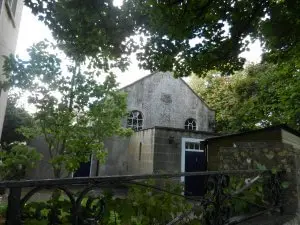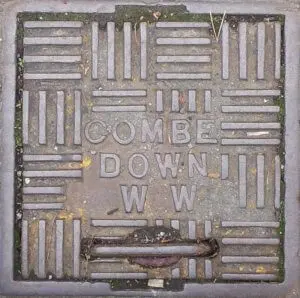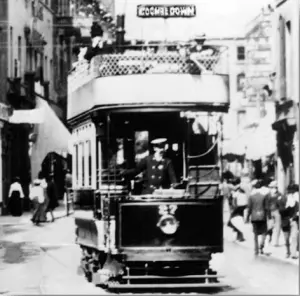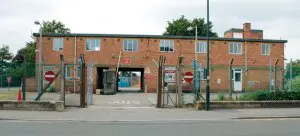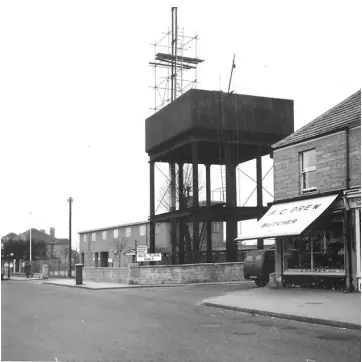This page is here to help to make it a bit easier to understand where to go on the site to find something and to find out more about the Combe Down development timeline. There’s quite a lot on site and even with sub menus it’s, sometimes, not easy to decide!
If you’re interested in seeing the timeline on maps try the maps of Combe Down page.
That is done by taking the heading and what comes immediately after to give you a clue. If you have an interest in a particular period click on one of these links to get to that time.
- On Combe Down before Ralph Allen
- On Combe Down at the time of Ralph Allen
- On Combe Down and Prior Park after Ralph Allen
- The Will and the Missing Earl
- On Combe Down before 1800
- On Combe Down from 1800 – 1805
- On Combe Down from 1805 – 1850
- On Combe Down from 1900 – 1950
- On Combe Down since 1950
Before Ralph Allen
We know there was Roman occupation on Combe Down, as a Roman Villa was found below Belmont Road in 1852. On a stone coffin lid that was found there was the inscription:
Combe Grove Manor has existed from about 1700, though it is possible that there was a house on the site before that. Pitcairn & Richardson say…
St. Michael and All Angels Church
St. Michael and All Angels Church is probably the longest occupied site in Monkton Combe. Collinson in 1791 says:
Ralph Allen
He was born in Cornwall in 1693 and baptised at St. Columb Major on 24 July 1693. His father, Philip is said to have kept a small inn called the ‘Duke William’ or the ‘Old Duke,’ at St. Blazey…
By 1719 Ralph Allen must have seen an opportunity and was confident enough to make a proposal to run the postal service which was not profitable…
In 1721 Ralph Allen married for the first time. He married Elizabeth Buckeridge (1687 – 1736), who was the daughter of Seaborne Buckeridge a London merchant who had left her one sixth of his estate when he died in…
In 1764 Ralph Allen went on a journey to London but at Maidenhead decided to return to Bath due to illness. On 29th June 1764 he died.
Prior Park after Ralph Allen
Ralph Allen (1693 – 1764) left his estate to his wife Elizabeth Holder but she died in 1766. By his will the estate then passed to his niece Gertrude Tucker (abt 1727 – 1796 ), who lived there for some years. However, after Ralph Allen’s death his postal contracts had been called in and thus the family income…
As stated above, in the period 1805 to 1807 Edward Candler Brown (1732 – 1807) was residing at Prior Park…
As the Maudes had never really lived at Prior Park, and he had no real family attachment to it, it seems reasonable to assume that there may have been little real attachment to it from Cornwallis Maude, 3rd Viscount Hawarden. In 1808, when he became 3rd Viscount, Prior Park was sold to John Thomas (1752 – 1827), a Quaker…
In 1829, Prior Park was bought by Bishop Baines for £22,000. He built two colleges at either end of the mansion house. He heightened and enlarged the East wing as a lay college which he dedicated to St. Peter…
Bathampton and Claverton Manors
Ralph Allen had also owned Bathampton Manor and Claverton Manor. He left Bathampton and Claverton Manor to his brother Philip Allen:
The will and the missing Earl
A number of sources I have consulted refer to “Allen’s heir, Earl de Montalt” or use a similar phrase. However, it soon became obvious that there was no Earl de Montalt in Allen’s time or for quite a while thereafter…
Will Of Ralph Allen. Extracted from the Register of the Prerogative Court of Canterbury.
On Combe Down before 1800
1764 to the early 1800s
Before 1710 when Ralph Allen came to Bath, it was a small place. It is said that when Samuel Pepys visited in 1668 Bath’s population was less than 1,200 and there were only about 150 houses…
Monkton Combe lock up
The lock up at Monkton Combe has two cells and was built around 1776 and, until about 1900, there used to be…
The Somerset Coal Canal
The southern boundary of the Combe Down is the Midford Brook and running parallel and just above this is the Somerset Coal Canal…
Lord Hawarden’s Mortgages
On 5th December 1799 there is a mortgage between Lord Viscount Hawarden, John Jeffreys Esq., the Earl of Exeter and William Phillimore Esq. for freehold and leasehold properties…
Midford Castle
Although Midford Castle is not strictly a part of Combe Down, it is so close and has a history that intertwines that mention must be made of it and its owners and occupiers…
On Combe Down from 1800 – 1805
1st Viscount Hawarden’s Will
Cornwallis Maude 1st Viscount Hawarden died in August 1803. His executors were Charles Stanley Monck, Baron Monck of Ballytramon and John Monck Mason who were both his brothers in law…
The Hadleys
The Hadleys should, perhaps, really be called the Laytons as it was Edward Layton (abt 1730 – 1805) of Southwark who had laid the foundations of their fortune…
Building Isabella Place
Edward Layton and the Hadleys bought large amounts of land on Combe Down. We have a plan of some of it at 15th – 16th January 1805…
William Smith and Tucking Mill
William ‘Strata’ Smith (23 March 1769 – 28 August 1839) is known as the “Father of English Geology”. He bought Tucking Mill in 1798 whilst he was still working for the Somerset Coal Canal to which he had become…
On Combe Down from 1805 – 1850
Jewish Cemetery
The first written record of Jewish settlement in England dates from 1070. The Jewish presence continued until King Edward I‘s Edict of Expulsion in 1290. After the expulsion…
Union Chapel
Prior to the Union Chapel the only place of worship on Combe Down was a room in Dial House, but a growing population of stone quarrymen meant a proper building was needed…
Monkton Combe Brewery
Large human settlements could develop only where fresh surface water was plentiful, such as near rivers, but far more often close to natural springs. For millennia this, generally, was fine but with industrialisation sewage and factories released more contaminants and…
Bath District National School
By November 1830 a school had been opened on Combe Down. Charity Sunday schools had been established in Bath in 1785 and by 1816 had led to the establishment of a ‘District National School’ at Weymouth House in St. James’s Street…
Holy Trinity Church
By 1831 there were enough residents for there to be a feeling that a church was needed for Combe Down. The land was purchased in December 1831 and the foundation stone laid in May 1832…
De Montalt Mill
On Thursday 8th July 1841 an advert appeared putting everything at De Montalt Mills up for sale. It had manufactured high quality paper, used by the great painter J.M.W. Turner (1775–1851)…
Frome Road Workhouse
Although it is, strictly, on Odd Down, it is worth mentioning the Frome Road Workhouse, later St. Martin’s Hospital…
Bath Abbey Cemetery
Bath Abbey, which dates back to 1499, sits on the remains of a massive Norman cathedral. Since that time thousands of people have been buried under the building…
On Combe Down from 1850 – 1900
Roman Villa
1852 saw the discovery of Roman remains on Combe Down. In 1822 Henry Mingden Scarth wrote…
Allotments
Allotments on Combe Down were introduced by Rev G W Newnham in 1852. The allotments were in the area bounded by North Road and Combe Road as shown on the map. This is the area to…
Wesleyan Chapel
Behind Glenburnie and adjacent to Gladstone Road is the Wesleyan Chapel which. according to Around Combe Down by Peter Addison was started in…
Combe Down Brewery
In 1851 the Hulonce family, who were quarry masters, sold the remainder of their 99 year lease, which included the Lyncombe & Widcombe side of Ralph Allen Yard…
De Montalt Mill and Charles Middleton Kernot
There were also a number of changes of use at De Montalt Mills. The Mill seems to have been unused in an industrial capacity since 1841 but on Thursday 13th July 1854 the Bath Chronicle announced it would reopen…
De Montalt Mill after Charles Middleton Kernot
In 1859, after Charles Kernot’s venture had foundered, De Montalt Mill became a laundry run by the Bath Washing Company Ltd. There is a…
Public Lighting on Combe Down
In 1818, an Act of Parliament was obtained for lighting Bath with gas. The gasometer was located near the Upper Bristol road and over eighteen miles of pipe were laid…
Perrymead Catholic Cemetery
Perrymead Catholic cemetery at Pope’s Walk, off Perrymead, is adjacent to Bath Abbey cemetery. It was consecrated in 1858. It has a mortuary chapel and the foundation stone…
Combe Down Omnibus
An omnibus is a public transport vehicle carrying many passengers generally quite short distances. John Greenwood ran the first English omnibus service in 1824 on the Manchester to Liverpool turnpike…
Monkton Combe School
Monkton Combe School was founded in 1868 by the vicar of Monkton Combe at the time, the Reverend Francis Pocock (1829 – 1919). There were six pupils for the Lent term who were taught in…
Combe Down Tunnel
The Somerset and Dorset Railway (S&D) was formed in 1862 by the amalgamation of Somerset and Dorset Central Railways. In 1870…
Combe Down Convalescent Home
The Combe Down convalescent home was founded in 1870 but soon proved inadequate in size. Many bazaars and concerts were held over a number of years to raise the money to build…
Combe Down Waterworks
Most people used shared wells with the well shafts passing through quarries below. The water from wells was often boiled first for use as drinking water. People also collected rainwater from their gutters, collecting it…
Bath Statutory Hospital
Many towns had some form of isolation hospital from the eighteenth century, usually a ‘pest house’, where infectious people were treated. It was not, however, until the late nineteenth century that…
Holy Trinity Church
On 7th August 1883 Mrs. Gore Langton of Newton Park laid the foundation stone for an extension to Holy Trinity…
Combe Down School
Combe Down School was founded by William Franklin (1852 – 1921) in 1886. Based on the 1891 census the school was in 2 properties (Combe Villa, which is now…
Magdalen Hospital School
Around 1100 a deed of gift was made by Walter Hosat, who gave his house and the Chapel of the Blessed Mary Magdalene at ‘Holeweye’ to the Abbey Church of St Peter, Bath. Its isolation, 500 yards from the city walls and across the River Avon, was…
Fullers Earth Company
There is evidence of Fuller’s earth mining in the Bath area from Roman times. Fuller’s earth resembles clay but is actually an absorbent silicate, mostly composed of silica, magnesium…
Combe Down Institute and Combe Down Rugby Football Club
In 1896 there was a proposal to form the Combe Down Institute. Church and other institutes were popular as they brought wholesome entertainment and sport to an area. The Institute at Combe Down was formed and…
Avenue Hall
Avenue Hall was the original name for what are now the Church Rooms, built and donated by Captain Oswald Borland R.N. (1820 – 1915). Captain Borland was also unfortunately involved in…
On Combe Down from 1900 – 1950
Bath Tramways
Bath had horse drawn trams from 1880. The reduced friction of rail tracks meant that horse drawn trams could carry more people on the flat in more comfort compared to horse drawn omnibuses. Slopes were a different…
The “Boundaries Fight”
1908 saw “the great boundaries fight”. Bath Corporation wanted to include Bathampton, Charlcombe, Monkton Combe and Twerton as well as parts of Batheaston, Claverton, Swainswick and Weston within…
Combe Down Sewerage
The question of mains sewerage had arisen for some years since the 1890s, but Combe Down was felt to be one of the “healthiest districts round about”. Although Pasteur had shown what was…
Fire protection on Combe Down
We take the existence of the fire service pretty much for granted. But, until very recently, that was not so. Although towns had some fire protection from insurance companies it was disjointed and…
Telephone service on Combe Down
Alexander Graham Bell (1847-1922) invented the telephone and made his first one in 1875. By 1879 two telephone companies were operating in London. In 1880 a court judgement said that…
The Glasshouse Farm Flying Field
In 1912 Herbert William Matthews, FRIBA (1874-1954), a Bath architect, who had helped to organize the hugely successful Bath pageant of 1909 and a friend, Claude Grahame-White, the first…
The Great War
At the beginning of the First World War, Prior Park was taken over by the army. In October 1914 the 2nd / 4th Somerset Light Infantry commanded by Lieut-Col. H. F. Clutterbuck were…
The Firs
In overcrowded Victorian cities parks were seen as a way of improving health and reducing discontent. Parks were provided by the new municipalities and rich philanthropists and seen as a way of providing a venue for leisure time activities that were better than drinking or gambling. An extension became…
Combe Down War Memorial
A meeting was held at Avenue Hall on 17th December 1918 to discuss a war memorial for Combe Down but no definite decision was arrived at, though the Firs had already been bought for £700…
The Fallen – Combe Down War Casualties
I started this after taking some photos of the war memorial cross on The Firs, having wondered about the people commemorated there. Who were they? What happened to them? What about their families? Surely we should…
Garden Village
Combe Down Garden Village – Bath Chronicle and Weekly Gazette – Saturday 24 March 1923…
Secret Chamber
In 1925 a ‘secret chamber’ was found on Church Road just outside Hopecote. At first it was reported as a coffin, then it was speculated to be a culvert and eventually it was decided it was…
Electric Lighting on Combe Down
Combe Down had been lit by gas light since 1865. In 1924 a petition to install electric public lighting to the 32 lamps was received by the Electric Lighting Committee of…
World War Two
The Admiralty moved about 4,000 personnel to Bath in September 1939. The majority of their staff worked in the centre of Bath in the Pump Room, the Empire, Pulteney and…
Admiralty Auxiliary Units
Prior Park also had Admiralty Patrol Units, part of the Auxiliary Units of the secret resistance organisation under the control of GHQ Home Forces. Auxiliary Units were…
Foxhill Estate
There had been concerns about housing in Bath and on Combe Down for years but before the Second World War the government would not sanction loans to local authorities for housing if it was felt that…
On Combe Down since 1950
The Monument Demolished
After Ralph Allen’s death Bishop Warburton had erected his own memorial to him on what is now known as Monument Field…
Street Numbering
Streets have often been named after a local landmark or person or something else that was memorable. Strange as it may seem to us, street numbering is a relatively recent innovation, though…
The National Trust
The National Trust has over 500 acres on Combe Down, at Lyncombe and Widcombe, Claverton Down and Bathwick, the bulk being the 242 acres of Rainbow Wood farm. This was willed to the Trust in 1959 by…
Ralph Allen School, Bath Clinic, Wessex Water and Combe Down Tunnel – Two Tunnels Greenway…
Contents

